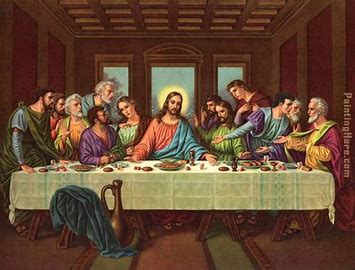What’s the history of the last supper coffin design?

The “Last Supper” coffin design refers to a coffin that features a depiction of The Last Supper, one of the most iconic scenes in Christian art, traditionally portraying Jesus Christ’s final meal with his apostles before his crucifixion. The design often incorporates imagery from this scene on the surface of the coffin, and it has become a specific style of artistic expression for those seeking to commemorate a loved one with a deeply symbolic and spiritual representation.
Historical Context of “The Last https://www.comparethecoffin.com/product/last-supper-tradition-coffin/Supper” Design
The image of The Last Supper is rooted in Christian tradition, with its earliest and most famous portrayal being Leonardo da Vinci’s The Last Supper painting (1495-1498), which shows Jesus and his disciples at the moment Jesus announces that one of them will betray him. This painting, held in the Convent of Santa Maria delle Grazie in Milan, Italy, became the most widely recognized version of the scene and has deeply influenced religious art over the centuries.
The image of The Last Supper in Christian art has evolved, appearing in many forms, from frescoes and altarpieces to prints and sculptures, as well as decorative objects like stained glass windows, prayer cards, and even furniture.
Emergence of Coffin Designs
While religious motifs like crosses, angels, and Biblical scenes have historically been used on coffins and burial goods, the idea of specifically incorporating The Last Supper into a coffin design seems to have become more popular in recent decades. The Last Supper is seen as a powerful and evocative scene in Christian symbolism, representing themes of sacrifice, redemption, and the bond between Christ and his followers. The imagery lends itself well to memorializing a loved one.
Development of Coffin Art in the 20th Century
In the 20th century, coffin designs became more personal, with people increasingly seeking unique ways to represent their faith and life stories. As technology advanced, coffins could be customized with printed imagery, including The Last Supper. Various wood types, such as oak or mahogany, could be engraved with the image or decorated with images painted or printed directly onto the surface. Some coffins feature a raised or sculpted representation of the scene, often with intricate detailing of Christ and the apostles.
These coffins have become especially popular in Christian communities, as the Last Supper symbolizes the themes of salvation, the importance of the Eucharist, and the Christian belief in life after death. The design has also taken on cultural significance in different parts of the world.
Symbolism and Modern Interpretations
Today, The Last Supper coffin is sometimes chosen to honor a loved one’s deep faith, marking the deceased’s connection with Christ and the belief in eternal life. The imagery serves as both a reflection on the last meal of Christ and as a tribute to the belief in Christ’s sacrifice and resurrection. The coffin, whether an artistic reproduction or a more simple symbolic rendering, can represent the hope for the deceased’s spiritual journey to eternal life.
Though it may not be as common as more traditional coffin designs, the Last Supper motif in modern coffins allows families and individuals to express their faith and personalize a funeral in a meaningful way, often reflecting the deceased’s religious devotion.
In summary, the Last Supper coffin design is a relatively modern interpretation of Christian funeral symbolism, gaining prominence due to the increased personalization of memorials. Its roots lie in centuries of religious art, particularly influenced by Leonardo da Vinci’s famous depiction.
What is the “last supper” ?
The Last Supper refers to the final meal that Jesus Christ shared with his disciples before his crucifixion, a pivotal event in Christian tradition. It is most famously depicted in the Bible, particularly in the Gospels of Matthew, Mark, Luke, and John, and it occurs on the night before Jesus’ arrest.
Key Aspects of the Last Supper:
- The Event: The Last Supper takes place on the evening of Passover (the Jewish festival commemorating the Exodus of the Israelites from Egypt). During this meal, Jesus shares bread and wine with his disciples, symbolizing his body and blood, and institutes the practice of Holy Communion (also known as the Eucharist) for Christians.
- Jesus’ Teachings: During the meal, Jesus delivers several important teachings, including predictions about his betrayal by one of the disciples, Peter’s denial, and his imminent suffering and death. This meal also marks the moment when Jesus establishes the new covenant between God and humanity, symbolized by the bread and wine.
- Betrayal: According to the Gospels, Jesus reveals that one of his disciples will betray him. This disciple is later identified as Judas Iscariot, who would go on to betray Jesus to the religious authorities for thirty pieces of silver. Jesus’ announcement of the betrayal is depicted as a moment of emotional tension during the meal.
- Significance of the Eucharist: The Last Supper is particularly important in Christian theology because it is where Jesus institutes the Eucharist, a sacrament that symbolizes his body and blood, to be shared by Christians in remembrance of him. The bread represents his body, and the wine represents his blood, which would be shed the following day during his crucifixion.
- The Farewell Discourse: After the meal, Jesus offers a series of teachings and prayers, often referred to as the “Farewell Discourse” (found in the Gospel of John). He speaks of love, the coming of the Holy Spirit, and prepares his disciples for the challenges they will face after his death.
The Last Supper in Art
The Last Supper is one of the most iconic scenes in Christian art. The most famous depiction is Leonardo da Vinci’s painting (1495-1498), which shows Jesus and his disciples seated at a long table. In this scene, Jesus announces that one of his disciples will betray him, and the various reactions of the disciples are captured in vivid detail.
Theological Importance
For Christians, the Last Supper holds deep theological significance. It marks the beginning of Jesus’ sacrificial journey toward his crucifixion and death, which Christians believe was necessary for the salvation of humanity. The sharing of bread and wine as the body and blood of Christ is a central ritual in Christian worship, symbolizing the believers’ connection to Christ and the salvation he offers.
The Last Supper is commemorated in many Christian traditions, especially on Maundy Thursday (the Thursday before Easter), which marks the occasion of the meal and the institution of the Eucharist. It is a key event leading to Good Friday, when Jesus was crucified, and Easter, when Christians celebrate his resurrection.
Recommended Posts

Rules about receiving and Transporting a Coffin
November 4, 2024

Burial: Myths and Facts?
January 14, 2021

